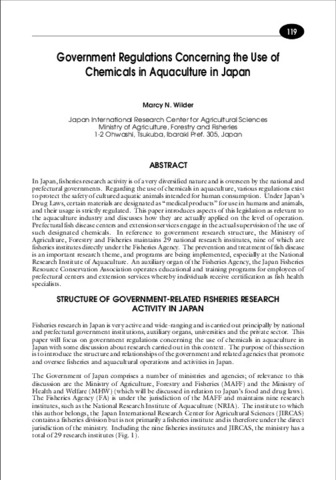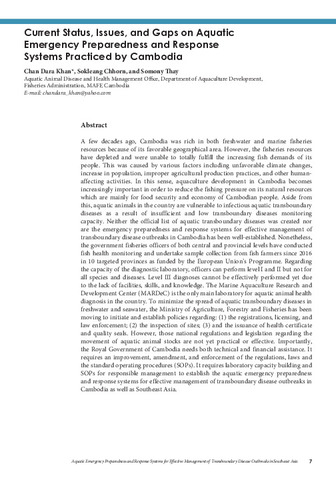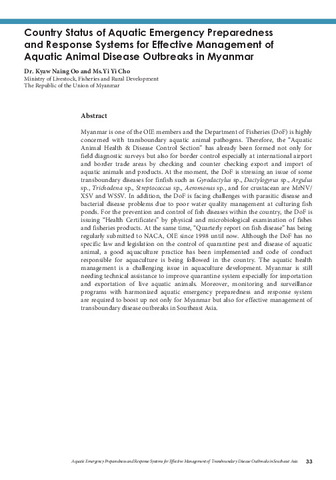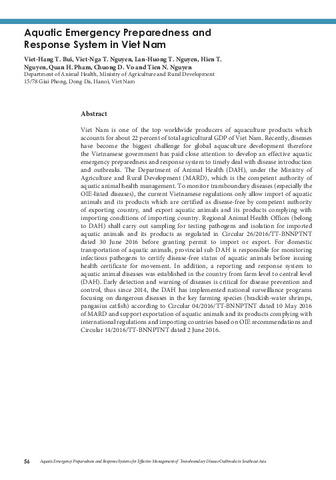Government regulations concerning the use of chemicals in aquaculture in Japan
Share
Abstract
In Japan, fisheries research activity is of a very diversified nature and is overseen by the national and prefectural governments. Regarding the use of chemicals in aquaculture, various regulations exist to protect the safety of cultured aquatic animals intended for human consumption. Under Japan’s Drug Laws, certain materials are designated as “medical products” for use in humans and animals, and their usage is strictly regulated. This paper introduces aspects of this legislation as relevant to the aquaculture industry and discusses how they are actually applied on the level of operation. Prefectural fish disease centers and extension services engage in the actual supervision of the use of such designated chemicals. In reference to government research structure, the Ministry of Agriculture, Forestry and Fisheries maintains 29 national research institutes, nine of which are fisheries institutes directly under the Fisheries Agency. The prevention and treatment of fish disease is an important research theme, and programs are being implemented, especially at the National Research Institute of Aquaculture. An auxiliary organ of the Fisheries Agency, the Japan Fisheries Resource Conservation Association operates educational and training programs for employees of prefectural centers and extension services whereby individuals receive certification as fish health specialists.
Suggested Citation
Wilder, M. N. (2000). Government regulations concerning the use of chemicals in aquaculture in Japan. In J. R. Arthur, C. R. Lavilla-Pitogo, & R. P. Subasinghe (Eds.), Use of Chemicals in Aquaculture in Asia: Proceedings of the Meeting on the Use of Chemicals in Aquaculture in Asia, 20-22 May 1996, Tigbauan, Iloilo, Philippines (pp. 119-126). Tigbauan, Iloilo, Philippines: Aquaculture Department, Southeast Asian Fisheries Development Center.
Subject
aquatic animals  ; policies
; policies  ; safety regulations
; safety regulations  ; aquaculture regulations
; aquaculture regulations  ; disease control
; disease control  ; aquaculture
; aquaculture  ; public health
; public health  ; training centres
; training centres  ; fish diseases
; fish diseases  ; pollutants
; pollutants  ; Personnel; fisheries
; Personnel; fisheries  ; Health and safety; certification
; Health and safety; certification  ; research
; research  ; chemical pollutants
; chemical pollutants  ; drugs
; drugs  ; legislation
; legislation  ; fish culture
; fish culture  ; Japan
; Japan
 ; policies
; policies  ; safety regulations
; safety regulations  ; aquaculture regulations
; aquaculture regulations  ; disease control
; disease control  ; aquaculture
; aquaculture  ; public health
; public health  ; training centres
; training centres  ; fish diseases
; fish diseases  ; pollutants
; pollutants  ; Personnel; fisheries
; Personnel; fisheries  ; Health and safety; certification
; Health and safety; certification  ; research
; research  ; chemical pollutants
; chemical pollutants  ; drugs
; drugs  ; legislation
; legislation  ; fish culture
; fish culture  ; Japan
; Japan
Koleksi
Related items
Showing items related by title, author, creator and subject.
-
Current status, issues, and gaps on aquatic emergency preparedness and response systems practiced by Cambodia
Khan, Chan Dara; Chhorn, Sokleang; Thay, Somony (Aquaculture Department, Southeast Asian Fisheries Development Center, 2019)A few decades ago, Cambodia was rich in both freshwater and marine fisheries resources because of its favorable geographical area. However, the fisheries resources have depleted and were unable to totally fulfill the ... -
Country status of aquatic emergency preparedness and response systems for effective management of aquatic animal disease outbreaks in Myanmar
Oo, Kyaw Naing; Cho, Yi Yi (Aquaculture Department, Southeast Asian Fisheries Development Center, 2019)Myanmar is one of the OIE members and the Department of Fisheries (DoF) is highly concerned with transboundary aquatic animal pathogens. Therefore, the Aquatic Animal Health & Disease Control Section has already been ... -
Aquatic emergency preparedness and response system in Viet Nam
Bui, Viet-Hang T.; Nguyen, Viet-Nga T.; Nguyen, Lan-Huong T.; Nguyen, Hien T.; Pham, Quan H.; Vo, Chuong D.; Nguyen, Tien N. (Aquaculture Department, Southeast Asian Fisheries Development Center, 2019)Viet Nam is one of the top worldwide producers of aquaculture products which accounts for about 22 percent of total agricultural GDP of Viet Nam. Recently, diseases have become the biggest challenge for global aquaculture ...




